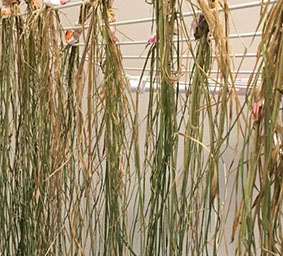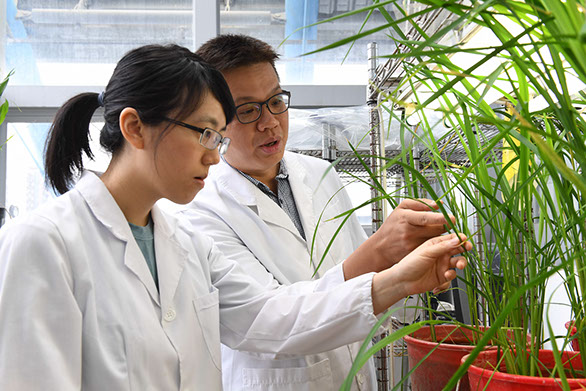Increasing demand for biofuel has seen
cellulose from non-edible plant materials such
as sugar cane leaves, corn stalks and rice
straw, being used as raw materials for
bioethanol production. The process was always hampered by the fact that cellulose is cross-linked with lignin in plant cell walls making it difficult to release the glucose from the
cellulose. Now, research by teams from HKU and Kyoto University has found a new strategy
to enable cellulose in straw to release fermentable sugar more efficiently.
HKU plant biochemist and principal investigator Dr Clive Lo Sze-chung said: “The collaboration began back in 2015 because we had published some papers in the international science journal, Plant Physiology, on a related area – the biosynthesis of tricin in rice. Dr Yuki Tobimatsu, who is a lignin specialist at Kyoto University, read the papers and was interested because tricin was recently recognised as a component of lignin in grass.

Dr Clive Lo Sze-chung
![]() The implications are that this strategy can be applied to different grass species, making them too more efficient raw materials for biofuel production.
The implications are that this strategy can be applied to different grass species, making them too more efficient raw materials for biofuel production. ![]()
Loosen the barrier
“Cellulose is the raw material for bioethanol, but until now lignin has been the barrier. Our work provides plants with modified lignin, so cellulose is more easily degraded. By manipulating tricin we can loosen the barrier but, at the same time, this process does not affect plant growth. The implications are that this strategy can be applied to different grass species, making them too more efficient raw materials for biofuel production.”
The work so far has been proof of concept – all done under laboratory conditions. Now the team is moving on to the next stage and seeking collaborations within the biofuel industry – possibly in the
US – to start heading towards market production. HKU’s Technology Transfer Office has already initiated the patent application process.
“I hope this will attract more funding for our laboratory so we can do more work in this area,” said
Dr Lo. “We would like to expand our research – this could work for other grass species in the Poaceae grass family such as corn, sorghum and switchgrass (a dedicated bioenergy crop) and for other cereals like maize, barley and wheat. These plants all produce tricin-bound lignin using the same set of enzymes, so we should be able to do the same for these other grasses.”
Mutant grass
“Yuki, who works mainly with rice and grasses, asked us if we could send him some materials, namely the mutant grass samples we have that can’t make tricin. We had a few discussions and exchanged ideas. Then I suggested that instead of sending him mutant grasses, perhaps my PhD student, Lydia Lam Pui-ying should go over to Kyoto to do the analysis. She spent eight months in Japan doing the research, and the results were very encouraging.”
What they discovered was that when flavone synthase II (FNSII) – a key enzyme involved
in tricin synthesis – was knocked out, not
only was tricin not produced, but the lignin content in rice straw was also reduced by
approximately one-third. Further, the amount
of glucose released from cellulose degradation was increased by 37 per cent without any chemical treatment.
“In short, this strategy allows more efficient production of bioethanol from cereal straw,” said Dr Lo. “Glucose released from cellulose can be used for bioethanol production and it is more efficient to produce ethanol from this kind of rice straw, which means the cost of lignin treatment can be reduced and the production of ethanol can be enhanced.

Biofuel Breakthrough
A collaboration between HKU and Kyoto University in Japan has resulted in a new strategy to improve the efficiency of cereal straw for biofuel production.
Cellulose in rice straw can be used for bioethanol production. However, the presence of lignin impedes the release of fermentable sugar from cellulose.
Dr Lydia Lam (left) and Dr Clive Lo (right) worked together with Kyoto University to reveal a new strategy to allow cellulose in rice straw to release its fermentable sugar more efficiently.
The findings were published in the June 2017 issue of the international science journal Plant Physiology.
Next
Back





